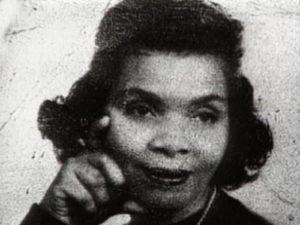The Journey
The History behind You Don’t Have to Ride JIM CROW!

A young Irene Morgan
Eleven years before Rosa Parks refused to give up her seat on a city bus in Montgomery, Alabama, a young woman named Irene Morgan rejected that same demand on an interstate bus headed to Maryland from Gloucester, Virginia. Recovering from a miscarriage and already sitting far in the back, she defied the driver’s order to surrender her seat to a white couple. Like Parks, Morgan was arrested and jailed. But her action caught the attention of lawyers from the NAACP, led by Thurgood Marshall, and in two years her case reached the Supreme Court.Though the lawyers fervently believed that Jim Crow – the curious pseudonym for racial segregation – was unjust, they recognized the practice was still the law of the land, upheld by the 1896 Supreme Court decision in Plessy v. Ferguson. Instead of seeking a judgment on humanitarian grounds or the equal protection provisions of the Fourteenth Amendment, they made the seemingly arcane argument that segregation in interstate travel violated the Constitution’s Interstate Commerce Clause.
On June 3, 1946, that strategy paid off. In Irene Morgan v. Virginia, the court ruled that segregation in interstate travel was indeed unconstitutional as “an undue burden on commerce.” But though that the decision was now law, the southern states refused to enforce it, and Jim Crow continued as the way of life in the South. Yet there were those determined to do something about it.
The Journey

Riders stop in front of Spottswood Robinson’s office, 1947.
In April 1947, the day before Jackie Robinson broke the color bar in major league baseball, eight white and eight black travelers prepared for a bus and train trip from Washington, D.C., to Louisville, Kentucky. With a strategy of whites sitting in the back seats, blacks in front and both side-by-side, they sought to force the Southern states to implement the Morgan decision.
Dubbed the “Journey of Reconciliation,” the two-week trip was highly dangerous and clearly not the norm for its time. Most African Americans lived in some sort of complacency with segregation; most whites ignored or violently enforced it. Warned by Southern friends that they would be taking their lives into their hands if they attempted interracial travel through the Deep South, they limited their trip to the Upper South only. Even there, their safety was far from guaranteed.
Along the route, the group spoke at NAACP groups and churches, and endured numerous arrests for violating local segregation laws. In Chapel Hill, North Carolina they were attacked by an angry mob of white cabdrivers. Even the white minister who took them in was threatened and forced to evacuate his family from their home.
Yet in the end, the participants viewed their trip a success. In the words of a song penned by Journey co-planners Bayard Rustin and George Houser, they had shown:
You don’t have to ride Jim Crow!
You don’t have to ride Jim Crow,
On June the Third the high court said
When you ride interstate, Jim Crow is dead,
You don’t have to ride Jim Crow…
Go quiet-like if you face arrest,
NAACP will make a test,
You don’t have to ride Jim Crow!
The last verse, however, proved untrue. NAACP lawyers, including Thurgood Marshall, became annoyed by this upstart group. Claiming to have lost the bus tickets needed for evidence, they reneged on a loose promise to represent them. The local convictions stood. Four were sentenced to 30 days on a chain gang.
Who were these idealistic travelers? All were men, most already carrying solid credentials as civil rights activists. A women’s Journey, planned for the following year, was scrapped after the lost court cases. So was another ride proposed for 1954 to the Deep South. The trip would not be repeated until 1961, when the Civil Rights Movement was full blown and the Freedom Rides were launched based directly on the Journey.
The Journey was sponsored by the pacifist Fellowship of Reconciliation and CORE, the Congress of Racial Equality. The ride’s co-leaders were Bayard Rustin and George Houser. A black Quaker, Rustin not only had a full resume as an activist, but also as a singer who performing backup to Paul Robeson and Leadbelly. Later, Rustin would organize the 1963 March on Washington. Only in recent years has his standing as a major civil rights leader in his own right – as well as his homosexuality, then too controversial to mention – gained widespread acceptance.
A white Methodist minister and a co-founder of CORE, George Houser too dedicated his career to challenging injustice. As the creator of the American Committee on Africa, he spent 30 years traveling to the continent helping in its struggle for self-determination in Africa.
Among other riders were noted civil rights attorney Conrad Lynn, Bill Worthy, who would become one of the first black television news correspondents, absolutist pacifist Wally Nelson, North Carolina journalist Joe Felmet, Methodist minister Ernest Bromley and the Rev. Dr. Nathan Wright, who would go on to chair the 1967 Black Power Conference. These portfolios are grossly abbreviated; all have spent a lifetime working for peace, equality and understanding.
Read next: The Documentary

 WordPress
WordPress